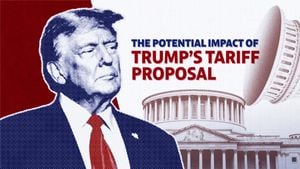President Donald Trump’s social media announcement on Thursday marked what he terms "a big one" as he reaffirmed his intention to impose reciprocal tariffs against foreign imports, aligning U.S. tariff rates with those of other countries. This unilateral move, which stems from Trump's longstanding campaign promise, aims to create what he sees as fair trade practices for American industries and workers.
"THREE GREAT WEEKS, PERHAPS THE BEST EVER, BUT TODAY IS THE BIG ONE: RECIPROCAL TARIFFS!!! MAKE AMERICA GREAT AGAIN!!!" Trump declared on his platform Truth Social. His post stirred excitement and anxiety as businesses, economists, and trading partners braced themselves for the potential fallout from these tariffs. But what does this really mean for the global economy?
Reciprocal tariffs mean imposing duties on imported goods equivalent to those already charged by trading partners on American exports. Trump stated simply, "if they charge us, we charge them" during his comments aboard Air Force One. The announcement follows several other tariff initiatives put forth by the Trump administration including hefty tariffs on steel and aluminum imports, which were positioned as necessary for national security and to bolster American manufacturing.
The specific details surrounding the reciprocal tariffs remain somewhat vague, though Trump signaled they would affect all countries imposing their own import duties. "The tariffs would be put in place almost immediately and affect every country," he claimed. Economically, this is seen as both a retaliatory measure and as leverage for negotiations, though its implementation details remain unclear.
While Trump has framed this strategy as beneficial for U.S. interests, multiple economists warn of the adverse effects. They point out how raising tariffs typically results not only in inflation but also as indirect tax increases on American consumers. The Peterson Institute for International Economics remarked on the probable price hikes resulting from such tariffs, projecting significant collateral damage to the U.S. economy.
Historically, tariffs were once primary revenue sources for many countries, but today they represent just about 2% of U.S. federal revenue. With Trump’s administration collecting approximately $77 billion from tariffs for the fiscal year of 2024, his administration has relied heavily on these measures to fund government initiatives.
Adding to the complexity of this scenario, Trump’s announcement closely precedes the visit of Indian Prime Minister Narendra Modi, who leads one of the countries with the highest tariff rates on U.S. exports. This has led to speculation about whether Trump is preparing to pressure Modi over trade practices during their discussions.
The idea of reciprocal tariffs has already sent ripples through the international business community. European leaders are bracing for potential retaliations, having already warned of consequences against what they term "unjustified tariffs" affecting their economies. Ursula von der Leyen, President of the European Commission, stated, "Tariffs are taxes, and they have proven to be bad for business and worse for consumers." She emphasized the EU would respond firmly and proportionately if Trump’s plans move forward.
Trade experts articulate significant logistical difficulties even if Trump’s administration intends to impose these tariffs effectively. Imposing tariffs on varying duty rates from numerous countries could result in cumbersome procedures and economic repercussions. Analysts stress the challenges will stem from dealing with over 186 nations, each with their unique tariffs and trade policies.
Notably, major sectors of the American economy express concern. Walmart and Best Buy, giant retailers, have explicitly pointed to price increases as probable outcomes from the proposed tariffs. With many consumer goods obtained from other nations, any new tariffs are anticipated to ripple through supply chains and lead to higher retail prices.
The political fallout from Trump’s tariffs may prove substantial as well. Margins for consumers tighten due to inflationary pressures, which can lead to dissatisfaction among voters. Trump’s opponents have already seized on the potential economic struggle resulting from such policies, warning they could make even basic necessities less affordable.
Trump's intention to make America competitive again through tariffs echoes sentiments from his first term, where fears of inciting trade wars with other nations became pronounced. Indeed, steadied dialogue has often been overshadowed by aggressive tariff announcements, making it challenging for global trade to stabilize under such policies.
Compounded by existing tensions with China amid previous tariff disputes, the chance for retaliation looms large. Chinese authorities issued statements opposing the tariffs, highlighting their intentions to respond to any U.S. actions viewed as unfair. This escalatory pattern raises the stakes, reflecting fears of triggering broader trade conflicts.
Environmental and technological sectors could also feel the impact, as Trump hinted at looming tariffs over steel, computer chips, and pharmaceuticals. Considering the delicate interconnectedness of global trade, these moves may risk over-extension and unintended consequences for American businesses reliant on complex supply chains.
The effects of Trump’s imminent tariff policies remain to be fully realized, especially considering the interconnectedness of global economies today. Headlines indicating the potential ramifications on inflation and employment permeate media outlets, as both domestic and international interests hold their breath awaiting Friday’s developments.
Trump’s message encapsulates his administration's perspective: "MAKE YOUR PRODUCT IN THE USA AND THERE ARE NO TARIFFS!" This declaration resonates as the banner under which his trade policies are launched. Trump's ratings have ebbed and flowed with economic indicators, making this strategy pivotal not just for policy, but politically. Whether these tariffs bolster his position remains to be seen as the global reaction mounts.



